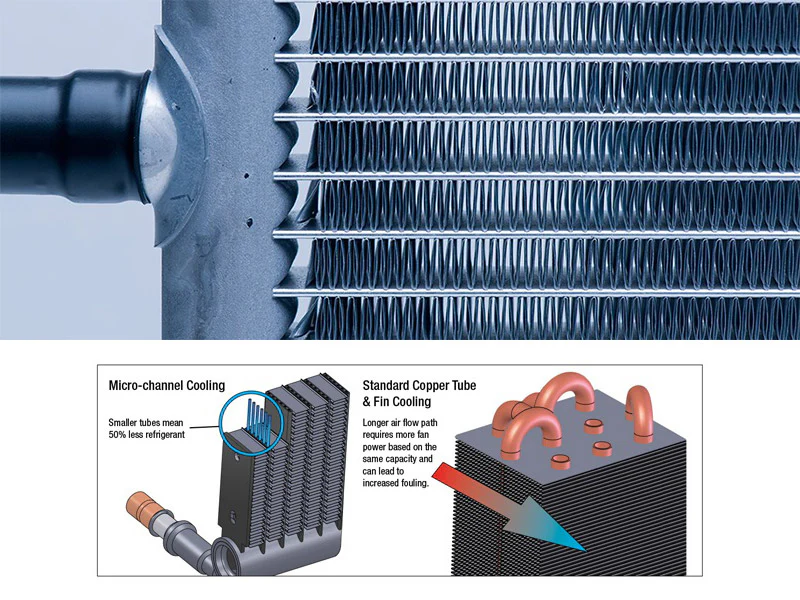Compact Cooling: The Next Big Shift in Thermal Management

Introduction
The microchannel heat exchanger market is gaining strong momentum due to the rising global emphasis on energy efficiency, compact design, and sustainability. These advanced heat exchangers are increasingly replacing conventional fin-and-tube systems in HVAC, automotive, power generation, and industrial applications. Their superior heat transfer efficiency, lightweight design, and reduced refrigerant requirements make them ideal for modern energy systems. As industries push toward carbon neutrality and cost optimization, the demand for microchannel heat exchangers continues to expand across both developed and emerging markets.
Understanding the Market
Microchannel heat exchangers are compact, high-performance devices designed to transfer heat between two fluids through small parallel channels. Their applications span air conditioning, refrigeration, and vehicle thermal systems. The growing adoption of electric vehicles (EVs) and stringent environmental regulations on refrigerant emissions are major market drivers. The automotive industry, in particular, utilizes these exchangers for battery cooling and air conditioning systems. Similarly, the HVAC sector benefits from reduced material usage and higher system efficiency. With the construction and commercial sectors focusing on energy-efficient solutions, the market’s relevance continues to grow globally. Asia-Pacific leads the market due to robust manufacturing activity, followed by North America and Europe, where regulatory norms support sustainable thermal technologies.
Technological Innovations
Technological advancements have significantly improved the design, performance, and durability of microchannel heat exchangers. Manufacturers are incorporating aluminum alloys and corrosion-resistant coatings to extend product life and reduce maintenance costs. Innovations such as additive manufacturing and advanced computational fluid dynamics (CFD) simulations enable precise optimization of heat flow and structural design. Additionally, hybrid models integrating microchannel and plate-fin technologies are emerging to enhance performance under extreme operating conditions. In the EV sector, new thermal management systems using microchannel designs are improving battery efficiency and range. These innovations not only enhance performance but also contribute to meeting global energy efficiency standards and sustainability goals.
Market Growth and Future Outlook
The microchannel heat exchanger market is projected to grow steadily, driven by global energy conservation initiatives and the increasing demand for compact, efficient thermal systems. The HVAC and automotive industries will remain dominant, but new opportunities are emerging in renewable energy and industrial cooling. As nations focus on reducing greenhouse gas emissions, the adoption of eco-friendly refrigerants in combination with microchannel designs will accelerate. The integration of smart control systems and IoT-based monitoring in heat exchangers is another trend shaping the market’s future. Moreover, as electric and hybrid vehicle adoption expands, microchannel solutions will play a vital role in optimizing heat management and improving energy utilization efficiency across sectors.
Challenges and Opportunities
Despite their advantages, microchannel heat exchangers face challenges such as high manufacturing precision requirements and limited tolerance for contamination or mechanical damage. The initial production cost is higher compared to traditional heat exchangers, which may hinder adoption in cost-sensitive markets. However, increasing focus on lifecycle efficiency, sustainability, and government incentives for green technologies present immense growth opportunities. The rapid expansion of the EV industry, coupled with advancements in HVAC systems for smart buildings, offers a lucrative growth path for manufacturers. Collaborations with renewable energy companies and industrial players for custom cooling systems will further open new revenue channels.
Conclusion
The microchannel heat exchanger market represents a key technological shift toward energy-efficient and sustainable thermal systems. As industries transition to greener practices, these compact exchangers are set to become a standard in HVAC, automotive, and power generation sectors. Technological innovation, material advancements, and growing demand for compact designs will continue to propel the market forward. Stakeholders focusing on research, design optimization, and long-term energy savings will gain a competitive edge in this evolving landscape, ensuring a cleaner and more efficient future for global industries.
- Art
- Education et Formation
- Crafts
- Sciences et Technologies
- Economie
- Politique
- Actualité
- Littérature
- Divertissement
- Histoire
- Health
- Actualité
- Shopping & Commerce
- Music
- Agriculture & élevage
- Voyage et Evènementiel
- Beauté & esthétique
- Religion
- Festival
- Sports
- Fête
- Autres



